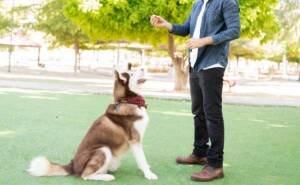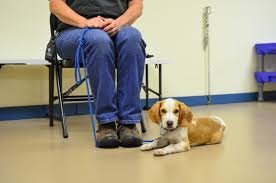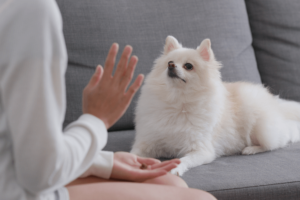Teaching your dog the ‘Sit’ command is a basic yet essential part of dog training. It’s not just about teaching your dog to sit – they naturally know how to do that. The training for this command primarily aims to instill traits like patience, obedience, attentiveness, and discipline in your dog. The ability for a dog to sit on command is particularly useful when you need precise control over their behavior. Moreover, teach your dog to sit on command is often used to calm your pet and prepare them for more complex commands that follow.
Methods to teach your dog to Sit on command
When training a dog to ‘Sit,’ both conditional and unconditional stimuli are used. Conditional stimuli include verbal commands and gestures, while unconditional stimuli involve mechanical and food-based incentives. Mechanical stimulation can be petting, pressing on the dog’s lower back, or a tug on the leash; food stimulation involves offering treats as a reward.
You can teach a dog to sit using exclusively food rewards or solely through mechanical means. A combined approach, known as the contrast method, is also practiced, each having its advantages and disadvantages.

Training with treats alone enhances the dog’s activity and fosters positive emotions associated with the command. This method is often indispensable in the early stages of training. However, using only mechanical means strengthens the dog’s obedience, enabling them to follow commands without the need for treats, which may not always be enticing.
The contrast training method for the ‘Sit’ command fosters obedience without fear or resistance. Experts believe that skills developed through this method are more durable. Many dogs are highly motivated by treats, eagerly sitting in anticipation of a reward. The key is to prevent them from snatching the treat prematurely. This approach is particularly effective with puppies and more aggressive dogs. However, some dogs may be indifferent to treats, finding their owner’s praise to be the best reward.
If you’re looking to get your dog trained, then here are some best dog trainer in gurugram.
From what age to start training a dog to the Sit command
Puppies can start learning the ‘Sit’ command as soon as they reach three months of age. At this tender age, well-trained puppies are usually already familiar with advance commands like ‘Come!’, ‘Place!’, ‘Heel!’, and ‘Lie Down!’ – The 5 basic commands to teach your new puppy.
The initial goal of teaching a puppy the ‘Sit’ command isn’t to have them execute it immediately and flawlessly. At a young age, the dog should simply start responding correctly to the owner’s command. The skill will become more refined over time.
Training puppies often involves using food as a reward. When practicing the command, you can gently hold the puppy by the collar. Mechanical actions such as pressing with the palm, leash tension, or tugs are more appropriate for physically stronger, older dogs. More formal training according to strict rules is typically started after the dog reaches six months of age.
How to teach your dog to Sit

Teaching a dog the “Sit!” command is a phased process, conducted in various environments. The aim is to ensure the dog reliably follows the command at home and outside, near the owner or at a distance, on a leash or during free play.
First, call the puppy by its name. It should come to you and stand by your left leg. Hold a treat in your right hand and let the puppy sniff this reward. Then, command “Sit!” and slowly raise your hand upwards, so the treat is above and slightly behind the puppy’s head. Focusing on the treat and trying to reach it, the puppy will likely lift its head and sit down.
If the dog attempts to get closer to your hand, gently hold it by the collar to prevent jumping. Encourage it to lift its head and sit. Once it sits, even if it’s a bit awkward, praise it with words like “Good!” or “Well done!”, pet it, and give the treat. Repeat this lesson 3-4 times with short breaks.
Once your dog begins to understand the “Sit!” command indoors, you can start practicing outdoors in a quiet area.
When your furry friend is 6-8 months old, start practicing the “Sit!” command on a short leash. Position the dog by your left leg and turn towards it. Hold the leash about 15 cm from the collar with your right hand, and place your left hand on the dog’s lower back near the tailbone, thumb pointing towards yourself. Command “Sit!” while pressing down on the lower back with your left hand and simultaneously pulling the leash upwards and slightly back with your right hand. Once your pet sits as desired, praise it with words like “Good!” or “Well done!”, pet it, and reward it with a treat. Repeat this exercise 3-4 times, taking approximately five-minute breaks.
Once your dog has mastered the “Sit!” command at close range, it’s time to practice this skill from a distance. Position your dog about 2-2.5 meters away, holding it on a leash. Get its attention, call its name, and command “Sit!”. As soon as your dog executes the command flawlessly, just like in previous training stages, reward it with verbal praise, a treat, and some petting. Repeat this exercise 3-4 times with short intervals.

Also read: How to teach your dog for fetch command
If your dog ignores the “Sit!” command from a distance, repeat the command with emphasized firmness. If this still doesn’t work, approach your pet, command it to sit again sternly, press on its lower back with your left hand, and pull the leash upward and slightly back with your right hand to ensure compliance. Then, step back to the same distance, face your stubborn learner, and repeat the command.
The dog should stay sitting for 5-7 seconds. After this time, either approach it or call it to you, reward it, and then release it with the command “Walk!”. If the dog gets up before the time is up and rushes towards you without permission, immediately lead it back to its starting position on the leash and repeat the exercise.
After your dog consistently follows the “Sit!” command from up to three meters away, you can start increasing the distance, eventually practicing off-leash. During these sessions, systematically change the distance between you and your dog. However, regardless of the distance, it is essential to approach your dog after each successful execution of the command to praise, pet, or treat it. It’s crucial to maintain the dog’s perception of the command’s significance, regardless of whether it is close to you or at a distance. This ensures consistent response to commands in any situation.
Training the Sit Command with a Gesture

Once your dog has basic skills in responding to the verbal “Sit!” command, it’s advisable to reinforce the command with a gesture. The dog should be positioned about two steps in front of the owner. Before starting, ensure the collar and leash’s clip is facing downwards. Holding the leash in your left hand, apply slight tension. Quickly move your bent right arm to the side, raise it upwards with an open palm, and command: “Sit!”. A well-executed command, of course, deserves a traditional reward.
The gesture used for sitting can vary; it could be an upward palm or even a finger. In this case, hold the treat between the thumb and middle finger, pointing the index finger upwards.
Progressively, train your dog to sit using both the verbal command and the gesture synchronously. However, it’s important to occasionally separate these overlapping commands, meaning sometimes issue the command using only words or only the gesture.
According to training standards, a skill is considered well-established if the dog immediately sits without hesitation from various positions upon the owner’s first command or gesture, even at a distance of 15 meters. The dog should remain in this position for at least 15 seconds.
What not to do during the learning process
In the process of training your dog, there are certain actions to overcome dog training challenges, as they can hinder the learning process and negatively affect your dog’s response to training:
- Do not reward the dog if it sits but immediately stands up again. This confuses the command’s meaning and can lead to inconsistent behavior.
- Avoid getting distracted and forgetting to issue the command to end the sitting position (“Walk!” or similar). Without this, the dog may change its position at will, disrupting the training routine.
- Do not use a loud, sharp, or high-pitched voice when giving the “Sit!” command. Also, avoid abrupt gestures or threatening postures. These can frighten the dog, making it wary and less likely to obey.
- Avoid repeating the “Sit!” command multiple times before the dog sits and you reward it. This can lead to the dog not responding to the command promptly in the future, as it learns to wait for repeated commands.
- Be careful not to press too hard on the dog’s sacrum or jerk the leash harshly. This can cause pain and discomfort to the dog, leading to a negative association with the training and the commands.
Tips from dog handlers

When selecting an outdoor training area for your dog, ensure it’s clean and free of objects that could injure your pet. Avoid making your dog sit on dirty, wet, or even damp ground.
Issue the “Sit!” command in a firm yet calm tone. If you need to repeat a command that wasn’t followed, use a slightly raised, more assertive tone. However, avoid any scolding or threatening tones in your voice. Your words of encouragement should carry a gentle, reassuring tone.
As your dog becomes more confident and consistent in executing the “Sit!” command, gradually reduce the number of treats given as rewards. However, always praise and pet your dog for flawlessly executing the command.
Each execution of the “Sit!” command should be followed by a reward and the issuance of another command. The dog shouldn’t get up on its own accord. After your dog performs the “Sit!” command and you’ve praised it, pause for 5 seconds before giving another command, like “Lie Down!” or “Stand!”

